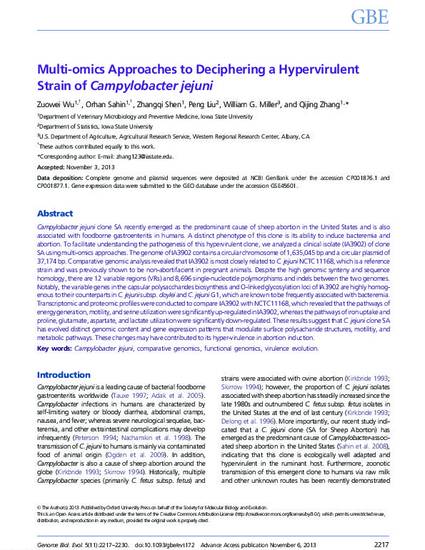
Article
Multi-omics Approaches to Deciphering a Hypervirulent Strain of Campylobacter jejuni
Genome Biology and Evolution
Document Type
Article
Disciplines
Publication Version
Published Version
Publication Date
11-1-2013
DOI
10.1093/gbe/evt172
Abstract
Campylobacter jejuni clone SA recently emerged as the predominant cause of sheep abortion in the United States and is also associated with foodborne gastroenteritis in humans. A distinct phenotype of this clone is its ability to induce bacteremia and abortion. To facilitate understanding the pathogenesis of this hypervirulent clone, we analyzed a clinical isolate (IA3902) of clone SA using multi-omics approaches. The genome of IA3902 contains a circular chromosome of 1,635,045 bp and a circular plasmid of 37,174 bp. Comparative genomic analysis revealed that IA3902 is most closely related to C. jejuni NCTC11168, which is a reference strain and was previously shown to be non-abortifacient in pregnant animals. Despite the high genomic synteny and sequence homology, there are 12 variable regions (VRs) and 8,696 single-nucleotide polymorphisms and indels between the two genomes. Notably, the variable genes in the capsular polysaccharides biosynthesis and O-linked glycosylation loci of IA3902 are highly homogenous to their counterparts in C. jejuni subsp. doylei and C. jejuni G1, which are known to be frequently associated with bacteremia. Transcriptomic and proteomic profiles were conducted to compare IA3902 with NCTC11168, which revealed that the pathways of energy generation, motility, and serine utilization were significantly up-regulated in IA3902, whereas the pathways of iron uptake and proline, glutamate, aspartate, and lactate utilization were significantly down-regulated. These results suggest that C. jejuni clone SA has evolved distinct genomic content and gene expression patterns that modulate surface polysacharide structures, motilitiy, and metabolic pathways. These changes may have contributed to its hyper-virulence in abortion induction.
Rights
Works produced by employees of the U.S. Government as part of their official duties are not copyrighted within the U.S. The content of this document is not copyrighted.
Language
en
File Format
application/pdf
Citation Information
Zuowei Wu, Orhan Sahin, Zhangqi Shen, Peng Liu, et al.. "Multi-omics Approaches to Deciphering a Hypervirulent Strain of Campylobacter jejuni" Genome Biology and Evolution Vol. 5 Iss. 11 (2013) p. 2217 - 2230 Available at: http://works.bepress.com/qijing-zhang/44/

This article is published as Wu, Zuowei, Orhan Sahin, Zhangqi Shen, Peng Liu, William G. Miller, and Qijing Zhang. "Multi-omics approaches to deciphering a hypervirulent strain of Campylobacter jejuni." Genome biology and evolution 5, no. 11 (2013): 2217-2230. doi:10.1093/gbe/evt172. Posted with permission.